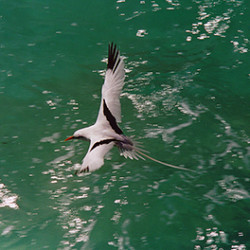Plants and Animals
BirdsCorals
Fish
Plants
Learn
BZS Schools' ProgrammeVisiting School Groups
Camps
Youth and Teen Programmes
Adult and Young Adult Programmes
Guides and Resources
Plants and Animals
Contact
General Inquiries
info@bzs.bm
Birds

Habitat:
The White-tailed Tropicbird or Longtail is an oceanic bird, which means that it spends most of its life at sea. However, they must come to land to nest in February and March, usually staying until November. Bermuda is one of their nesting locations and they have probably used the islands in this way for thousands of years. Longtails use holes in coastal cliffs around Bermuda as their nesting habitat. Since the arrival of man this habitat has been taken over or plundered by several introduced species, including the Rock Dove or Pigeon (Columba livia) and rats.
Characteristics:
Longtails are quite large birds, with a wingspan reaching about 3 feet or 1 metre. The body is black- and-white and the beak reddish. The black parts are a streak back from the eye and the wing-tips, top and bottom. On the back and wing-tops a prominent black “V” begins near the front-centre of each wing to end on top of the tail (over). The other distinctive feature is the pair of very long graceful tail feathers which give the bird its name. Young Longtails are a fuzzy white with a speckling of black on the wings.
Similar Birds:
No other bird in Bermuda can be confused with the Longtail.
Conservation Importance:
Longtails are important native nesting birds in Bermuda. The local nesting population averages about 2,500 pairs, the largest in the Western Atlantic region. Increased competition for nesting cavities has, however, reduced their nesting success in recent years. Unfortunately this has also caused Tropicbirds to try to use the artificial nest cavities for the Bermuda Petrel or Cahow (Pterodroma cahow). To alleviate both these problems, artificial dome-shaped nesting boxes (called igloos), have been designed and placed in suitable locations around the shoreline of Bermuda. Additionally, Cahow burrow entrances were re-designed with a baffle to exclude Longtails. These measures, together with the culling of pigeons, have helped Bermuda’s Longtails. The Pigeons are, however, very prolific and keeping their numbers down is a never- ending task


